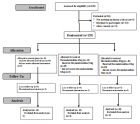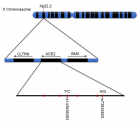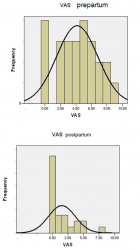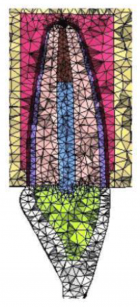Abstract
Research Article
Intravitreal Ranibizumab/ Lucentis (IVTL) injections in Glaucoma patients-Intraocular Pressure (IOP) elevation and the use of Anterior Chamber Paracentesis (ACP)
EA Ansari*
Published: 20 September, 2017 | Volume 1 - Issue 1 | Pages: 033-041
Purpose
• To assess the short term effects of intravitreal Lucentis (IVTL) on intraocular pressure in patients with ocular hypertension and glaucoma
• To determine rate of anterior chamber paracentesis (ACP) required post-injection according to departmental protocol
Methods
This was a prospective, observational study carried out between August 2011 and February 2012 in the Department of Ophthalmology, Maidstone Hospital. 24 participants (13 female, 11 male) with established ocular hypertension (OHT) or glaucoma were chosen from a cohort of patients receiving intravitreal (IVTL) Ranibizumab (Lucentis) treatment for wet age related macular degeneration (wARMD). Apraclonidine 1% was given pre-injection, and baseline IOP was measured 30 min. after this, just before IVTL. IOP was measured at baseline, within 1 min of injection, 5 min, 15 min, 30 min up to 60min following a single IVTL treatment.
Anterior paracentesis was performed if:
• Immediate post injection IOP > 50mm Hg and OHT
• Immediate post injection IOP > 40 mm Hg and there was evidence of disc damage only
• Immediate post injection IOP > 30mm Hg with evidence of disc damage and visual field loss
Results
79.2% had diagnosed disc damage and visual field loss (glaucoma); 12.5% had disc damage only (pre-perimetric glaucoma), whereas the remaining 8.3% had no evidence of disc damage or visual field loss i.e. ocular hypertension (OHT).
Administration of Apraclonidine 1% prior to IVTL did not cause a statistically significant IOP reduction in patients with OHT and glaucoma (paired Student’s t-test P = 0.368). Immediately post injection, mean IOP was 41.54mm Hg (SD 14.1, 95% CI 37.20 to 45.88; Paired T test results P <0.0001,) which confirmed a statistically significant difference between baseline and immediate post injection IOP.
13 out of 24 (58%) of the study patients required anterior chamber paracentesis (ACP) post IVTL according to our devised protocol. There was no statistically significant difference in baseline IOP between the paracentesis and non-paracentesis groups (p=0.4). The presence of a bleb post injection had no statistically significant bearing on immediate post intravitreal IOP (p=0.3).
ACP performed at 1min restored IOP to a safer level at 5min in all cases thus treated.
Conclusions
IVTL appears to cause a significant but transient rise in IOP which is reduced after a mean time of 5 minutes. Although the clinical significance of this IOP spike is still unknown, extreme care must be taken in patients with ocular hypertension and glaucoma particularly those with established disc damage and visual field loss. Apraclonidine 1% appears to have a limited role in the prophylactic lowering of IOP pre-injection. The authors propose the use of the formulated anterior chamber paracentesis protocol for IOP management in patients with OHT and glaucoma receiving intravitreal anti-VEGF treatment.
Read Full Article HTML DOI: 10.29328/journal.hceo.1001005 Cite this Article Read Full Article PDF
Keywords:
Age-related macular degeneration (ARMD); Glaucoma; Ocular hypertension; Ranibizumab/Lucentis; Intraocular pressure; Intravitreal injection; Anti-VEGF Abstract
References
- Kvanta A, Algvere PV, Berglin L, Seregard S. Subfoveal fibrovascular membranes in age related macular degeneration express vascular endothelial growth factor. Invest Ophthalmol Vis Sci. 1996; 37: 1929-1934. Ref.: https://goo.gl/1thLnq
- Shams N, Ianchulev T. Role of vascular endothelial growth factor in ocular angiogenesis. Ophthalmol Clin North Am. 2006; 19: 335-344. Ref.: https://goo.gl/Wu4JFG
- Bressler SB. Introduction: understanding the role of angiogenesis and antiangiogenic agents in age-related macular degeneration. Ophthalmology. 2009; 116: S1-S7. Ref.: https://goo.gl/Ffvuky
- Package insert. Avastin (Bevacizumab). San Francisco: Genentech, 2004.
- Package insert. Lucentis (Ranibizumab). San Francisco: Genentech, 2006.
- Zondor SD, Medina PJ. Bevacizumab: an angiogenesis inhibitor with efficacy in colorectal and other malignancies. Ann Pharmacother. 2004; 38: 1258-1264. Ref.: https://goo.gl/ez9Qk8
- Bressler NM. Antiangiogenic approaches to age-related macular degeneration today. Ophthalmology. 2009; 116: S15-S23. Ref.: https://goo.gl/MWv72s
- Rich RM, Rosenfeld PJ, Puliafito CA. Short-term safety and efficacy of intravitreal bevacizumab (Avastin) for neovascular age-related macular degeneration. Retina. 2006; 26: 495-511. Ref.: https://goo.gl/5RCmZv
- Fung AE, Rosenfeld PJ, Reichel E. The International intravitreal bevacizumab safety survey: using the internet to assess drug safety worldwide. Br J Ophthalmol. 2006; 90: 1344-1349. Ref.: https://goo.gl/3u7tYn
- Gordon A, Maximiliano M. Bevacizumab local complications. Ophthalmology. 2009; 116: 2264. Ref.: https://goo.gl/utdoR4
- Jalil A, Fenerty C, Charles S. Intravitreal bevacizumab (Avastin) causing acute glaucoma: an unreported complication. Eye (Lond). 2007; 21: 1541. Ref.: https://goo.gl/PfJa8j
- Zheng Q, Mayer H, Adelman RA. Persistent ocular hypertension following multiple intravitreal Anti-VEGF Injections for AMD. Invest Ophthalmol Vis Sci. 2009; 50: 959. Ref.: https://goo.gl/GVLoHd
- Bakri SJ, McCannel CA, Edwards AO. Persistent ocular hypertension following intravitrea ranibizumab. Graefes Arch Clin Exp Ophthalmol. 2008; 246: 955-958. Ref.: https://goo.gl/wwEcRJ
- Kahook MY, Kimura AE, Wong LS. Sustained elevation of intraocular pressure associated with intravitreal bevacizumab injections. Ophthalmic Surg Lasers Imaging. 2009; 40: 293-295. Ref.: https://goo.gl/WznkVq
- Good TJ, Kimura AE, Mandava N, Kahook MY. Sustained elevation of intraocular pressure after intravitreal injections of anti-VEGF agents. Br J Ophthalmol. 2011; 95: 1111-1114. Ref.: https://goo.gl/2Fc6GL
- Rashid A, Quhill F, Pushpoth S. Effect of Iopidine administration prior to intravitreal Lucentis injection on intraocular pressure spike. Invest Ophthalmol Vis Sci. 2009; 50. Ref.: https://goo.gl/N9LQN1
- El Chehab H, Le Corre A, Giraud JM. Efficacy of prophylactic treatment of intraocular pressure spikes due to intravitreal injections. J Fr Ophtalmol. 2012; 35: 614-621. Ref.: https://goo.gl/ovKRSE
- Fortune B, Burgoyne CF, Cull GA. Structural and functional abnormalities of retinal ganglion cells measured in vivo at the onset of optic nerve head surface change in experimental glaucoma. Invest Ophthalmol Vis Sci. 2012; 53: 3939-3950. Ref.: https://goo.gl/JpYkWP
- The Advanced Glaucoma Intervention Study (AGIS): 7. The Relationship Between Control of Intraocular Pressure and Visual Field Deterioration THE AGIS INVESTIGATORS. Am J Ophthalmol. 2000; 130: 429-440. Ref.: https://goo.gl/thpmvq
- Carver J, Bouska C, Corey R. Avastin and risk of glaucoma [abstract]. New York: Retina Congress, 2009.
- Frenkel MP, Haji SA, Frenkel RE. Effect of prophylactic intraocular pressure lowering medication on intraocular spikes after intravitreal injections. Arch Ophthalmol. 2010; 128: 1523-1527. Ref.: https://goo.gl/G2YmUr
- Kim JE, Mantravadi AV, Hur EY, Covert DJ. Short term intraocular pressure changes immediately after intravitreal injections of anti-vascular endothelial growth factor agents. Am J Ophthalmol. 2008; 146: 930-934. Ref.: https://goo.gl/Tey8J2
- Hollands H, Wong J, Bruen R, Campbell RJ, Sharma S. Short-term intraocular pressure changes after intravitreal injection of bevacizumab. Can J Ophthalmol. 2007; 42: 807-811. Ref.: https://goo.gl/iUWVVg
- Sharei V, Hohn F, Kohler T, Hattenbach LO, Mirshahi A. Course of intraocular pressure after intravitreal injection of 0.05mL ranibizumab (Lucentis). Eur J Ophthalmol. 2010; 20: 174-179. Ref.: https://goo.gl/15oqcJ
- Gismondi M, Salati C, Salvetat ML, Zeppieri M, Brusini P. Short-term effect of intravitreal injection of Ranibizumab (Lucentis) on intraocular pressure. J Glaucoma. 2009; 18: 658-661. Ref.: https://goo.gl/9ZNRnV
- Usman SM, Batra R, Qureshi F, Clark D. Reflux of drug during intravitreal anti-VEGF therapies. Semin Ophthalmol. 2011; 26: 357-360. Ref.: https://goo.gl/Dbng6T
- Arikan G, Osman SA, Hakan OF. Immediate intraocular pressure rise after intravitreal injection of ranibizumab and two doses of triamcinolone acetonide. Int J of Ophthal. 2011; 4: 402-405. Ref.: https://goo.gl/iy8jj2
- Kahook MY, Liu L, Ruzycki P. High-molecular-weight aggregates in repackaged bevacizumab. Retina. 2010; 30: 887-892. Ref.: https://goo.gl/9B4iji
- Nabili S, Stevenson M, Chakravarty U. Short-term effect of intravitreal anti-VEGFs delivery on intraocular pressure. Br J Ophthalmol. 2009; 93: 552–553. Ref.: https://goo.gl/1By6KZ
- Drance SM. The significance of the diurnal tension variations in normal and glaucomatous eyes. Arch Ophthalmol. 960; 64: 494-501. Ref.: https://goo.gl/XHdVi7
- Stewart WC, Chorak RP, Hunt HH, Sethuraman G. Factors associated with visual loss in patients with advanced glaucomatous changes in the optic nerve head. Am J Ophthalmol. 1993; 116: 176-181. Ref.: https://goo.gl/FhSTBx
- Tranos P, Bhar G, Little B. Postoperative intraocular pressure spikes: the need to treat. Eye(Lond). 2004: 673-679. Ref.: https://goo.gl/aBbJcp
- Buono LM, Foroozan R, Sergott RC, Savino PJ. Nonarteritic anterior ischemic optic neuropathy. Curr Opin Ophthalmol. 2002; 13: 357-361. Ref.: https://goo.gl/ugH8z4
- Basile C, Addabbo G, Montanaro A. Anterior ischemic optic neuropathy and dialysis: role of hypotension and anemia. J Nephrol. 2001; 14: 420-423. Ref.: https://goo.gl/XruK3z
- Koker AE. Visual prognosis in advanced glaucoma: a comparison of medical and surgical therapy for retention of vision in 101 eyes with advanced glaucoma. Trans Am OphthalmolSoc. 1977; 75: 539-555. Ref.: https://goo.gl/XBLkvi
- Savage JA, Thomas JV, Belcher III CD. Extracapsular cataract extraction and posterior chamber intraocular lens implantation in glaucomatous eyes. Ophthalmology. 1985; 92: 1506-1516. Ref.: https://goo.gl/aoTPUh
- Colotto A, Falsini B, Salgarello T, et al. Transiently raised intraocular pressure reveals pattern electroretinogram losses in ocular hypertension. Invest Ophthalmol Vis Sci. 1996; 37: 2663-2670. Ref.: https://goo.gl/qRD2U1
- Chan KC, Poostchi A, Wong T, et al. Visual field changes after transient elevation of intraocular pressure in eyes with and without glaucoma. Ophthalmology. 2008; 115: 667-672. Ref.: https://goo.gl/A8J4xv
- Yandan Zhou, Minwen Zhou, Shigang Xia, et al. Sustained Elevation of Intraocular Pressure Associated with Intravitreal Administration of Anti-vascular Endothelial Growth Factor: A Systematic Review and Meta-Analysis. Sci Rep. 2016; 6: 39301. Ref.: https://goo.gl/cQepW1
- Freund, K.B, Hoang, Q.V, Saroj N, Thompson D. Intraocular Pressure in Patients with Neovascular Age-Related Macular Degeneration Receiving Intravitreal Aflibercept or Ranibizumab. Ophthalmology. 2015; 122: 1802-1810. Ref.: https://goo.gl/eoKt2c
Figures:

Figure 1

Figure 2

Figure 3
Similar Articles
-
Intravitreal Ranibizumab/ Lucentis (IVTL) injections in Glaucoma patients-Intraocular Pressure (IOP) elevation and the use of Anterior Chamber Paracentesis (ACP)EA Ansari*. Intravitreal Ranibizumab/ Lucentis (IVTL) injections in Glaucoma patients-Intraocular Pressure (IOP) elevation and the use of Anterior Chamber Paracentesis (ACP) . . 2017 doi: 10.29328/journal.hceo.1001005; 1: 033-041
-
Detection of Ganglion Cell Loss in Preperimetric Glaucoma by Fourier-Domain Optical Coherence TomographySuneeta Dubey*, Baswati Prasanth,Lokesh Chauhan, Saptarshi Mukherjee. Detection of Ganglion Cell Loss in Preperimetric Glaucoma by Fourier-Domain Optical Coherence Tomography. . 2017 doi: 10.29328/journal.hceo.1001006; 1: 042-048
-
The management of Irvine-Gass Syndrome in a patient using Inhaler SteroidAyse Gul Kocak Altintas*,Cagri Ilhan,Mehmet Citirik. The management of Irvine-Gass Syndrome in a patient using Inhaler Steroid . . 2018 doi: 10.29328/journal.ijceo.1001011; 2: 001-005
-
Place of beta-radiation in the etiology and treatment of cataractYasemin Benderli Cihan*. Place of beta-radiation in the etiology and treatment of cataract . . 2018 doi: 10.29328/journal.ijceo.1001012; 2: 006-007
-
Treatment of Retinal Pigment Epithelial DetachmentAyse Gul Kocak Altintas*,Cagri Ilhan. Treatment of Retinal Pigment Epithelial Detachment . . 2018 doi: 10.29328/journal.ijceo.1001013; 2: 008-014
-
Ocular changes and disorders associated with ObesityBurak Turgut*. Ocular changes and disorders associated with Obesity. . 2018 doi: 10.29328/journal.ijceo.1001015; 2: 018-020
-
Is community based case detection of glaucoma relevant? Intraocular Pressure level and vertical Cup Disc ratio of participants at a screening programme in a rural setting in NigeriaElizabeth A Awoyesuku*,Ireju O Chukwuka. Is community based case detection of glaucoma relevant? Intraocular Pressure level and vertical Cup Disc ratio of participants at a screening programme in a rural setting in Nigeria . . 2018 doi: 10.29328/journal.ijceo.1001017; 2: 022-026
-
Outcome of Trabeculectomy in Advanced Glaucoma in a tertiary hospital in Rivers State, NigeriaAwoyesuku EA*,Fiebai B . Outcome of Trabeculectomy in Advanced Glaucoma in a tertiary hospital in Rivers State, Nigeria . . 2018 doi: 10.29328/journal.ijceo.1001018; 2: 027-031
-
Two different patterns and outcome of neodymium YAG capsulotomySudeep Navule Siddappa*, Darshan Shivaura Mahalingu, Rakesha Anjenappa,Tintu Susan Joy. Two different patterns and outcome of neodymium YAG capsulotomy. . 2020 doi: 10.29328/journal.ijceo.1001027; 4: 012-014
-
Changes in intraocular pressure after ND-yag laser posterior capsulotomyHashim Thiab Hassan*. Changes in intraocular pressure after ND-yag laser posterior capsulotomy. . 2020 doi: 10.29328/journal.ijceo.1001029; 4: 021-030
Recently Viewed
-
Prediction of neonatal and maternal index based on development and population indicators: a global ecological studySedigheh Abdollahpour,Hamid Heidarian Miri,Talat Khadivzadeh*. Prediction of neonatal and maternal index based on development and population indicators: a global ecological study. Clin J Obstet Gynecol. 2021: doi: 10.29328/journal.cjog.1001096; 4: 101-105
-
A Genetic study in assisted reproduction and the risk of congenital anomaliesKaparelioti Chrysoula,Koniari Eleni*,Efthymiou Vasiliki,Loutradis Dimitrios,Chrousos George,Fryssira Eleni. A Genetic study in assisted reproduction and the risk of congenital anomalies. Clin J Obstet Gynecol. 2021: doi: 10.29328/journal.cjog.1001095; 4: 096-100
-
Leiomyosarcoma in pregnancy: Incidental finding during routine caesarean sectionToon Wen Tang*,Phoon Wai Leng Jessie. Leiomyosarcoma in pregnancy: Incidental finding during routine caesarean section. Clin J Obstet Gynecol. 2021: doi: 10.29328/journal.cjog.1001094; 4: 092-095
-
Adult Neurogenesis: A Review of Current Perspectives and Implications for Neuroscience ResearchAlex, Gideon S*,Olanrewaju Oluwaseun Oke,Joy Wilberforce Ekokojde,Tolulope Judah Gbayisomore,Martina C. Anene-Ogbe,Farounbi Glory,Joshua Ayodele Yusuf. Adult Neurogenesis: A Review of Current Perspectives and Implications for Neuroscience Research. J Neurosci Neurol Disord. 2024: doi: 10.29328/journal.jnnd.1001102; 8: 106-114
-
Late discover of a traumatic cardiac injury: Case reportBenlafqih C,Bouhdadi H*,Bakkali A,Rhissassi J,Sayah R,Laaroussi M. Late discover of a traumatic cardiac injury: Case report. J Cardiol Cardiovasc Med. 2019: doi: 10.29328/journal.jccm.1001048; 4: 100-102
Most Viewed
-
Evaluation of Biostimulants Based on Recovered Protein Hydrolysates from Animal By-products as Plant Growth EnhancersH Pérez-Aguilar*, M Lacruz-Asaro, F Arán-Ais. Evaluation of Biostimulants Based on Recovered Protein Hydrolysates from Animal By-products as Plant Growth Enhancers. J Plant Sci Phytopathol. 2023 doi: 10.29328/journal.jpsp.1001104; 7: 042-047
-
Sinonasal Myxoma Extending into the Orbit in a 4-Year Old: A Case PresentationJulian A Purrinos*, Ramzi Younis. Sinonasal Myxoma Extending into the Orbit in a 4-Year Old: A Case Presentation. Arch Case Rep. 2024 doi: 10.29328/journal.acr.1001099; 8: 075-077
-
Feasibility study of magnetic sensing for detecting single-neuron action potentialsDenis Tonini,Kai Wu,Renata Saha,Jian-Ping Wang*. Feasibility study of magnetic sensing for detecting single-neuron action potentials. Ann Biomed Sci Eng. 2022 doi: 10.29328/journal.abse.1001018; 6: 019-029
-
Pediatric Dysgerminoma: Unveiling a Rare Ovarian TumorFaten Limaiem*, Khalil Saffar, Ahmed Halouani. Pediatric Dysgerminoma: Unveiling a Rare Ovarian Tumor. Arch Case Rep. 2024 doi: 10.29328/journal.acr.1001087; 8: 010-013
-
Physical activity can change the physiological and psychological circumstances during COVID-19 pandemic: A narrative reviewKhashayar Maroufi*. Physical activity can change the physiological and psychological circumstances during COVID-19 pandemic: A narrative review. J Sports Med Ther. 2021 doi: 10.29328/journal.jsmt.1001051; 6: 001-007

HSPI: We're glad you're here. Please click "create a new Query" if you are a new visitor to our website and need further information from us.
If you are already a member of our network and need to keep track of any developments regarding a question you have already submitted, click "take me to my Query."
















































































































































